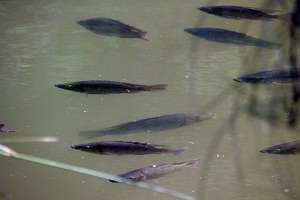Fish monitoring stepped up in bid to stop invasive species

An invasive fish species currently occupying the Chapman River is being monitored in research exploring the effectiveness of different capture methods.
The Durack Institute of Technology's Batavia Coast Maritime Institute (BCMI) in Geraldton has just completed a Recfishwest sponsored preliminary survey on tilapia.
Tilapia (Oreochromis mossambicus) is an invasive fish native to Africa and is part of the cichlid family of fish of which there are more than100 variants.
"Tilapia are a massive pest worldwide and their presence in the Chapman River which is a fairly small discontinuous waterway lends itself to exploring methods of removal," BCMI's Colin Johnson says.
Dr Johnson oversaw the survey which was conducted by BCMI students and was the major project for diploma student Kirsten Surmon.
"[It was my job] to design and implement a complex field experiment as one of the core units of the diploma," she says.
Students sampled fish using seine nets, fyke nets and various types of boxtrap, line fishing, dip netting and visual surveys and examined data from previous surveys.
Sampling sites included all significant permanent water bodies within the Chapman River main channel but no tilapia have been found above the Utakarra gauging station 9kms upstream of the river mouth.
Tilapia were found predominantly in the permanent estuarine region which is a body of water approximately 2km in length, disconnected from the ocean for most of the year.
"If we do find them upstream of the estuary, particularly in some of the smaller waterholes, these are some discreet areas where it might be possible to conduct comparative trials for removal techniques as well as impact studies of tilapia presence," Dr Johnson says.
It is not clear how tilapia got into the Chapman River but it seems likely they were released as ornamental fish.
Fieldwork for this project ran from mid May until late October during which time they conducted 19 separate sampling expeditions with 3000 total hours of sampling time.
This study saw the beginning of a larger project under the Australian Government's Caring For Our Country program, to be jointly managed by BCMI and the Northern Agricultural Catchment Council.
"The project will run until 2017 and will survey the Irwin, Greenough and Murchison Rivers with focus on biodiversity, tilapia monitoring and developing tilapia control strategies in the region," Dr Johnson says.
He says if the tilapia has spread significantly into other local rivers the focus will change from control through removal to preventing further spread.
Provided by Science Network WA
















